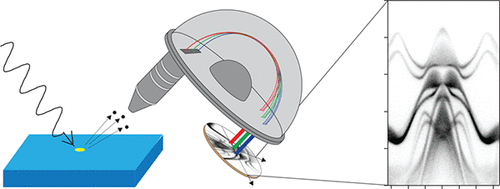当前位置:
X-MOL 学术
›
Chem. Rev.
›
论文详情
Our official English website, www.x-mol.net, welcomes your
feedback! (Note: you will need to create a separate account there.)
Angle, Spin, and Depth Resolved Photoelectron Spectroscopy on Quantum Materials
Chemical Reviews ( IF 51.4 ) Pub Date : 2020-12-21 , DOI: 10.1021/acs.chemrev.0c00616 Phil D. C. King 1 , Silvia Picozzi 2 , Russell G. Egdell 3 , Giancarlo Panaccione 4
Chemical Reviews ( IF 51.4 ) Pub Date : 2020-12-21 , DOI: 10.1021/acs.chemrev.0c00616 Phil D. C. King 1 , Silvia Picozzi 2 , Russell G. Egdell 3 , Giancarlo Panaccione 4
Affiliation

|
The role of X-ray based electron spectroscopies in determining chemical, electronic, and magnetic properties of solids has been well-known for several decades. A powerful approach is angle-resolved photoelectron spectroscopy, whereby the kinetic energy and angle of photoelectrons emitted from a sample surface are measured. This provides a direct measurement of the electronic band structure of crystalline solids. Moreover, it yields powerful insights into the electronic interactions at play within a material and into the control of spin, charge, and orbital degrees of freedom, central pillars of future solid state science. With strong recent focus on research of lower-dimensional materials and modified electronic behavior at surfaces and interfaces, angle-resolved photoelectron spectroscopy has become a core technique in the study of quantum materials. In this review, we provide an introduction to the technique. Through examples from several topical materials systems, including topological insulators, transition metal dichalcogenides, and transition metal oxides, we highlight the types of information which can be obtained. We show how the combination of angle, spin, time, and depth-resolved experiments are able to reveal “hidden” spectral features, connected to semiconducting, metallic and magnetic properties of solids, as well as underlining the importance of dimensional effects in quantum materials.
中文翻译:

量子材料上的角度,自旋和深度分辨光电子能谱
几十年来,基于X射线的电子光谱学在确定固体的化学,电子和磁性方面的作用是众所周知的。一种有效的方法是角度分辨光电子能谱,从而测量从样品表面发射的光电子的动能和角度。这提供了结晶固体电子带结构的直接测量。此外,它还提供了对材料内所起作用的电子相互作用以及对自旋,电荷和轨道自由度(未来固态科学的核心支柱)的控制的深刻见解。近年来,随着对低维材料的研究以及表面和界面的改进电子行为的关注,角分辨光电子能谱已经成为量子材料研究的核心技术。在这篇综述中,我们提供了对该技术的介绍。通过来自几种主题材料系统的示例,包括拓扑绝缘体,过渡金属二卤化物和过渡金属氧化物,我们重点介绍了可以获取的信息类型。我们展示了角度,自旋,时间和深度解析实验的组合如何能够揭示与固体的半导体,金属和磁性性质相关的“隐藏”光谱特征,以及强调量子效应在量子材料中的重要性。和过渡金属氧化物,我们重点介绍了可以获取的信息类型。我们展示了角度,自旋,时间和深度解析实验的组合如何能够揭示与固体的半导体,金属和磁性性质相关的“隐藏”光谱特征,以及强调量子效应在量子材料中的重要性。和过渡金属氧化物,我们重点介绍了可以获取的信息类型。我们展示了角度,自旋,时间和深度解析实验的组合如何能够揭示与固体的半导体,金属和磁性性质相关的“隐藏”光谱特征,以及强调量子效应在量子材料中的重要性。
更新日期:2020-12-21
中文翻译:

量子材料上的角度,自旋和深度分辨光电子能谱
几十年来,基于X射线的电子光谱学在确定固体的化学,电子和磁性方面的作用是众所周知的。一种有效的方法是角度分辨光电子能谱,从而测量从样品表面发射的光电子的动能和角度。这提供了结晶固体电子带结构的直接测量。此外,它还提供了对材料内所起作用的电子相互作用以及对自旋,电荷和轨道自由度(未来固态科学的核心支柱)的控制的深刻见解。近年来,随着对低维材料的研究以及表面和界面的改进电子行为的关注,角分辨光电子能谱已经成为量子材料研究的核心技术。在这篇综述中,我们提供了对该技术的介绍。通过来自几种主题材料系统的示例,包括拓扑绝缘体,过渡金属二卤化物和过渡金属氧化物,我们重点介绍了可以获取的信息类型。我们展示了角度,自旋,时间和深度解析实验的组合如何能够揭示与固体的半导体,金属和磁性性质相关的“隐藏”光谱特征,以及强调量子效应在量子材料中的重要性。和过渡金属氧化物,我们重点介绍了可以获取的信息类型。我们展示了角度,自旋,时间和深度解析实验的组合如何能够揭示与固体的半导体,金属和磁性性质相关的“隐藏”光谱特征,以及强调量子效应在量子材料中的重要性。和过渡金属氧化物,我们重点介绍了可以获取的信息类型。我们展示了角度,自旋,时间和深度解析实验的组合如何能够揭示与固体的半导体,金属和磁性性质相关的“隐藏”光谱特征,以及强调量子效应在量子材料中的重要性。











































 京公网安备 11010802027423号
京公网安备 11010802027423号